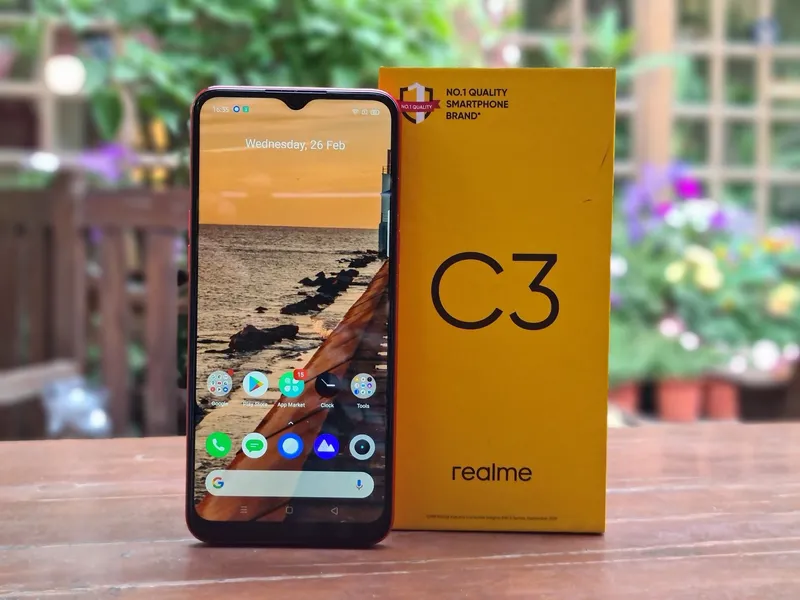Realme C3: The smartphone that punches above its weight with brilliant gaming performance
This week, we review Realme C3, a truly budget smartphone that takes on the likes of Xiaomi’s Redmi 8A. At Rs 6,999, find out if it holds its ground despite the affordable price tag.
Indian smartphone buyers are spoiled for choice in the Rs 10,000-20,000 price range, which has seen astounding growth both in terms of the sheer number of new device launches and in sale of units. However, the under-Rs 10,000 segment had been neglected for a long time; ask anyone for recommendations and they’d struggle to come up with one.
But, ever since Xiaomi entered the market, there has been a solid offering in the below-Rs 10,000 segment. Asus tried to bring out a device or two but it didn’t really light the market on fire. Now, the Realme C3 may be the strongest competitor yet to Redmi’s Redmi 8A, Redmi 8.

The Realme C3 takes on Redmi 8A/Redmi 8A Dual with ease, and if you’re a gamer, you’re going to be quite pleased with what you see. Let’s dive deep to find out if the Realme C3 is worth the price tag of Rs 6,999.
Design and display
The smartphone stands apart from the crowd, and especially from its predecessor, Realme C2. The Realme C3 has a striking sun-rays pattern on the rear, the casing for which is textured and sturdy. This helps avoid fingerprint smudges and the ridges allow for a better grip.
While the camera module protrudes at the back it doesn’t take away from the design.
On the left side of the device is the volume rocker and the SIM-card tray. The right houses the power button. At the bottom reside the 3.5mm headphone jack, the single speaker, and the micro-USB port.
The Realme C3 comes with a 6.5-inch HD+ LCD display with bezels on all four sides, the most prominent of them being the chin. There’s a waterdrop notch—still the norm in the budget segment—that houses the front camera. The display comes with a 20:9 aspect ratio and is protected by Corning Gorilla Glass 3 (slightly disappointing not to see Gorilla Glass 5).

The colours are punchy and bright, though sunlight legibility leaves a lot to be desired. There’s no Widevine L1 support which means this smartphone should not be your go-to device for streaming Netflix, Amazon Prime, or videos from any other OTT platform.
The smartphone weighs just 195gm and is very comfortable to hold in the hand for a long duration. This becomes especially important if you’re a gamer.
Unparalleled gaming experience
The Realme C3 is the first smartphone in India to use the MediaTek Helio G70 - an octa-core processor based on the 12nm manufacturing process, and aimed squarely at gamers. This is a game-changer in the below-Rs 10,000 price segment.
The smartphone provides by far the best gaming experience I’ve had on a smartphone that is priced this low. I tested out Call of Duty, PUBG, FIFA Mobile, and others on the device, and while the experience wasn’t flawless, for its price range the Realme C3 delivered hours of gaming like no other. It did not heat up too much nor did it lag greatly either.
The smartphone is equipped to handle PUBG at HD settings and it does as it says.
Performance

The Realme C3 is a true budget smartphone. So this means it’s going to lag when multiple apps are opened. It’s also going to slow down when, say, 20 Google Chrome tabs are kept open.
Realme’s UI isn’t as slick as some of the other competing Android skins out there. But, for its price, that’s a small price to play. The Realme C3 punches above its weight and takes on smartphones that are being sold at a couple of thousand rupees more.
Battery life
The Realme C3 has a beefy 5,000mAh battery, surpassing the 4,230mAh battery that its predecessor hosted. Given that this smartphone isn’t equipped for heavy usage—apart from gaming—the device comfortably lasts two days on a single charge. I easily got about six hours of screen-on time during my week-long usage.
Some downsides

The dual-camera—12-megapixel primary and 2-megapixel depth sensor—setup on the Realme C3 just isn’t worth it. One has to have an abundance of good light to get a decent shot. There is no Night Mode, and selfies don’t come out great either.

On the other hand, the Asus Zenfone Max Pro M2 or even the Redmi Note 8 selling for just a few thousand of rupees more have a better camera setup.
With the entire Redmi range—from the Redmi 8A to the Redmi Note 8 Pro—having adopted the Type-C port, its high time the competition takes notice. The Realme C3 comes with a micro-USB port and that’s one of the major downsides to this device. It’s 2020 and companies should be shelving the micro-USB port. Instead, here we are, rummaging through our drawers for an old micro-USB port.
The other drawback is the lack of a fingerprint scanner. One has to resort to using facial recognition on the Realme C3 if you don’t want to type in a PIN or use a pattern to unlock your smartphone. The facial recognition component is very inconsistent, no matter what the lighting situation.
Verdict: is the Realme C3 worth it?
The Realme C3 is a compelling successor to the Realme C2. Along with the Redmi 8A Dual, it makes for a good option in the under-Rs 10,000 segment. And if you’re a fan of gaming then you can blindly opt for it over the Redmi 8A Dual.
The Realme C3 is priced at Rs 6,999 (3GB RAM and 32GB storage) and Rs 7,999 (4GB RAM and 32GB storage).

It has a massive display, great battery life, and superlative gaming performance going for it. It also boasts of a better UI than that from competitor Xiaomi. It’s a sturdy device that will make for a great starter smartphone.
The Realme C3 ticks off a lot of boxes but it does leave a lot to be desired. The Indian smartphone landscape is evolving rapidly and if you’re not a hardcore gamer nor in much of a hurry, then it’s best to hold off on the Realme C3 and see what the company has to offer next.
(Edited by Evelyn Ratnakumar)







